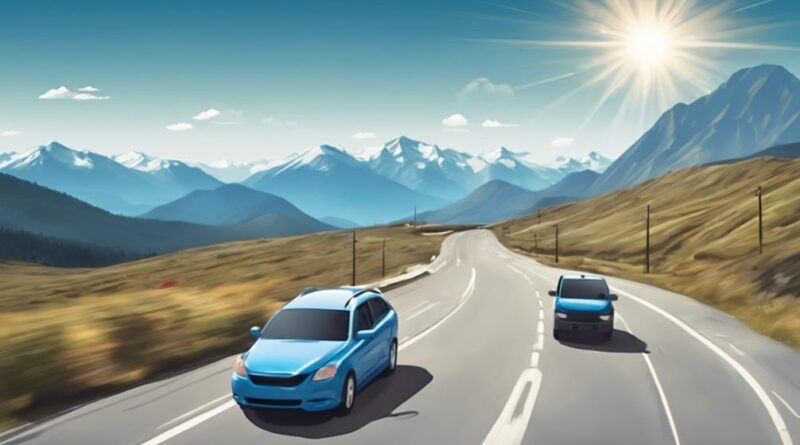Securing Your Safety on Long-Distance Road Journeys
When embarking on extended road trips, it's essential to take precautions to ensure your well-being.
From meticulous planning to proactive measures, securing your safety on long-distance journeys demands attention to detail and preparedness.
By implementing a few key strategies, you can significantly reduce risks and enhance your overall travel experience.
Remember, prioritizing safety is not just a choice but a necessity when hitting the open road for extended periods.
Planning Your Route Carefully
When embarking on a long-distance road journey, ensure you plan your route meticulously to ensure a safe and smooth trip. Utilize navigation apps like Google Maps or Waze to help you find the most efficient routes, avoid traffic congestion, and receive real-time updates on road conditions. These apps can also provide alternative routes in case of unexpected road closures or accidents along your way.
By inputting your destination into a navigation app, you can access detailed turn-by-turn directions, estimated arrival times, and information about nearby gas stations or restaurants for pit stops. This level of preparation helps you stay focused on the road and minimizes the chances of getting lost or taking unnecessary detours.
In addition to using navigation apps, it's crucial to stay informed about any potential road closures that may affect your journey. Check for any planned construction or detours along your route before you depart to avoid delays and frustrations. Road closures can significantly impact your travel time, so staying updated on these changes is essential for a hassle-free trip.
Ensuring Vehicle Maintenance Before Departure
Before setting off on your long-distance road journey, ensuring proper vehicle maintenance is essential to prevent unexpected breakdowns and ensure a safe trip. Start by conducting a thorough vehicle inspection. Check the tire pressure, tread depth, and overall condition of the tires. Ensure all lights are working correctly, including headlights, brake lights, and turn signals. Don't forget to inspect the brakes to guarantee they're responsive and in good working order.
Next, go through a safety checklist. Make sure your seatbelts are functioning correctly and adjust your mirrors for optimal visibility. Test the horn and windshield wipers to ensure they're operational. Check the oil level and top it up if needed, also inspect the coolant and brake fluid levels. Verify that the spare tire is in good condition and that you have all necessary tools for changing a flat tire.
Additionally, consider getting a professional inspection if your vehicle is due for maintenance. Address any issues promptly to avoid potential problems on the road. By taking the time to ensure your vehicle is well-maintained before departure, you significantly reduce the risk of encountering mechanical failures during your journey, contributing to a safer and more enjoyable trip.
Packing Emergency Supplies
Ensure your vehicle is equipped with essential emergency supplies to handle unexpected situations during your long-distance road journey. Having emergency food and water is crucial in case you get stranded or face delays. Pack non-perishable items like energy bars, nuts, or dried fruits, along with an adequate supply of water to stay hydrated until help arrives.
A well-stocked first aid kit is another essential item to include in your emergency supplies. Make sure it contains bandages, antiseptic wipes, pain relievers, and any necessary medications for you or your passengers. Being prepared for minor injuries can make a significant difference in handling emergencies promptly.
Additionally, having basic tools in your vehicle can help you address mechanical issues on the road. Include items like a tire iron, jumper cables, a flashlight, and a multi-tool kit. These tools can assist you in changing a flat tire, jump-starting your battery, or making minor repairs if needed.
Staying Alert and Avoiding Fatigue
To maintain your safety on long-distance road journeys, staying alert and avoiding fatigue is crucial for a smooth and secure trip. Here are some essential tips to help you stay sharp and focused during your travels:
- Energy-Boosting Snacks and Hydration: Pack healthy snacks like nuts, fruits, or granola bars to keep your energy levels up. Additionally, staying hydrated by drinking water regularly can help combat fatigue.
- Active Engagement and Mental Stimulation: Keep your mind engaged to prevent drowsiness. Listen to upbeat music, interesting podcasts, or audiobooks. Engage in conversations with your travel companions or use hands-free devices to make calls (if permitted by law). Stimulating your brain can help you stay alert on the road.
- Regular Breaks and Stretching: Make sure to take short breaks every couple of hours to stretch your legs and rest your eyes. Consider doing some quick exercises or taking a brisk walk during these stops to boost circulation and alertness.
- Proper Rest Before the Journey: Adequate rest before embarking on a long drive is essential. Aim for 7-9 hours of quality sleep the night before to ensure you start your journey well-rested and alert.
Adhering to Speed Limits and Traffic Rules
Adhere to speed limits and traffic rules diligently to enhance road safety during your journey. By following these regulations, you not only protect yourself but also contribute to the overall safety of all road users. Utilize defensive driving techniques to anticipate and avoid potential hazards. Maintaining awareness of traffic flow around you through constant analysis helps in making informed decisions on the road.
Speed monitoring devices such as speed cameras are in place to ensure compliance with speed limits. Keep an eye out for these devices and adjust your speed accordingly. Additionally, road sign recognition is crucial for understanding upcoming road conditions, warnings, and speed limit changes. Familiarize yourself with common road signs to react promptly and appropriately.
Utilizing GPS and Navigation Tools
When embarking on long-distance road journeys, leverage GPS and navigation tools to enhance your travel experience and ensure efficient route guidance. Here's how you can make the most of these technological aids:
- GPS Accuracy: GPS systems provide accurate real-time information about your current location and upcoming turns. Rely on this accuracy to stay on the right track and avoid unnecessary detours.
- Traffic Updates: Stay ahead of traffic congestions and roadblocks by utilizing GPS systems that offer live traffic updates. This feature allows you to plan alternative routes and save time during your journey.
- Navigation Apps: Explore various navigation apps available for your smartphone, such as Google Maps or Waze. These apps offer user-friendly interfaces and additional features like estimated time of arrival and voice-guided directions.
- Offline Maps: Download offline maps of your route before setting off, especially if you anticipate traveling through areas with poor network coverage. Offline maps ensure you can navigate even when you're off the grid, providing a reliable backup in case of connectivity issues.
Making Regular Rest Stops

Regularly pausing your journey for rest stops is crucial to ensure your safety and maintain alertness while driving long distances. Taking breaks allows you to recharge both mentally and physically, reducing the risk of fatigue-related accidents. Hydration breaks are essential during these stops. Dehydration can lead to drowsiness and poor concentration, so remember to drink water regularly.
In addition to staying hydrated, incorporating stretching exercises into your rest stops can help prevent muscle stiffness and discomfort. When you sit for extended periods, your muscles can become tense, leading to decreased flexibility and potential cramps. Simple stretches like shoulder rolls, neck stretches, and leg extensions can promote blood circulation and keep you feeling more alert behind the wheel.
Plan your rest stops strategically, aiming for a break every two hours or 100 miles, whichever comes first. Look for designated rest areas, gas stations, or restaurants where you can safely pull over. Use these stops not only for physical rest but also to clear your mind. Take a short walk, grab a healthy snack, and perform some stretches before hitting the road again.
Being Prepared for Emergencies
Are you equipped to handle unexpected situations while on the road? When embarking on long-distance journeys, being prepared for emergencies is crucial for your safety. Here are some essential tips to ensure you're ready for any unforeseen circumstances:
- Emergency Kit: Always have a well-stocked emergency kit in your vehicle. Include items such as a first aid kit, flashlight, blankets, non-perishable snacks, water, and basic tools for minor repairs.
- Emergency Communication: Make sure you have a reliable way to communicate in case of emergencies. Keep a fully charged cell phone with emergency contact numbers saved, or consider investing in a satellite phone for remote areas.
- Roadside Assistance: Sign up for a roadside assistance service. Whether through your insurance provider or a separate service, having access to towing, tire changes, fuel delivery, and lockout services can be a lifesaver when facing car troubles.
- Emergency Plan: Develop a clear emergency plan with your travel companions. Establish meeting points, know who to contact in case of separation, and discuss what to do in various scenarios like getting lost or encountering severe weather.
Frequently Asked Questions
What Are Some Tips for Safely Driving Through Inclement Weather Conditions on Long-Distance Road Trips?
When driving through inclement weather on long trips, it's important to adjust your speed and maintain a safe distance. Use headlights and wipers, and avoid sudden maneuvers. Ensure tires have good tread and proper inflation. Pack emergency supplies like blankets and flashlights. Check weather reports before setting out. Consider roadside assistance coverage for added security.
How Can I Prevent Car Theft or Break-Ins While on a Long Journey?
To prevent car theft or break-ins on a long journey, consider installing anti-theft devices and window tinting. Vehicle tracking and alarm systems can also help keep your car safe.
By taking these precautions, you can deter potential thieves and protect your vehicle while traveling.
Are There Any Specific Safety Precautions I Should Take When Traveling Alone on a Long-Distance Road Trip?
When traveling alone on a long-distance road trip, it's crucial to prioritize your safety. Make sure to have an emergency kit with essentials like a flashlight and first aid supplies. Sign up for roadside assistance for added peace of mind.
Take breaks at well-lit rest stops and stay alert. Use navigation apps to plan your route and stay updated on road conditions. These precautions can help keep you safe during your journey.
What Should I Do if I Encounter Aggressive or Reckless Drivers While on the Road?
If you encounter aggressive or reckless drivers on the road, employ defensive driving techniques to protect yourself. Stay calm, keep a safe distance, and avoid engaging with them.
Don't react to their behavior or provoke them further. If necessary, change lanes or take an exit to remove yourself from the situation. Avoid escalating the conflict and prioritize your safety.
How Can I Stay Connected With Family and Friends for Safety Purposes During My Long-Distance Road Journey?
To stay connected with family and friends during your long-distance road trip, use emergency contacts and GPS tracking. Communication devices like smartphones can help with regular check-ins. It's important to share your itinerary and expected arrival times.
In case of emergencies, make sure your loved ones know how to reach you and where you are. These precautions can provide peace of mind for both you and your family.
Conclusion
When embarking on long-distance road trips, prioritizing safety is crucial. By planning your route, maintaining your vehicle, packing emergency supplies, staying alert, following speed limits, using GPS, making regular rest stops, and being prepared for emergencies, you can ensure a smooth and secure journey.
Remember, taking these precautions won't only protect you but also your passengers and fellow travelers on the road. Drive safely and enjoy the ride!
